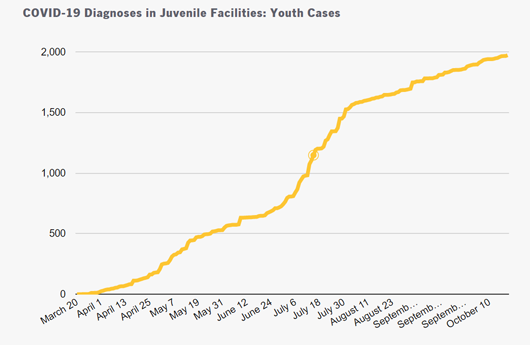Report: Youth Incarceration Is Largely Unnecessary

Giddings State School (Texas) | Courtesy of Google Maps
Youth justice systems have been challenged during the coronavirus pandemic to protect the safety and well-being of youth and staff. In a new report, the Sentencing Project compiles the lessons the juvenile justice system has learned to limit the spread of COVID-19. The report’s author, Josh Rovner, links the public health protections taken by youth justice systems — namely reducing the number of youths in secure confinement — with the movement for youth decarceration, arguing that youth incarceration is largely unnecessary.
COVID-19 and juvenile justice facilities
The report begins by tracking the growth of COVID-19 in juvenile justice facilities, based in part on research funded by the Annie E. Casey Foundation. The Sentencing Project calculates that between March and September 2020 more than 1,800 young people and 2,500 staff have tested positive for COVID-19 in juvenile detention centers, residential treatment facilities and other settings that make up the deep end of the juvenile justice system. Four staff members working in juvenile facilities have died from the virus.
Large, crowded facilities are destined to be breeding grounds for viruses, the report says. Further, as bad as the crisis in youth facilities has been, it would have been worse without two decades of juvenile justice reform that resulted in fewer youths in facilities overall and smaller, less crowded facilities. The national one-day count of youth in juvenile justice facilities was 65% lower in 2018 than in 2000: 37,529 youths were housed in 1,510 facilities around the country in 2018 compared to 108,802 youths in 3,047 facilities in 2000.

“This partial success not only justifies past reforms that closed large youth prisons and sought alternatives to incarceration, but points to a further need to close more youth facilities and promote alternatives to incarceration that keep kids safely in the community with their families,” Rovner writes.
Recommendations to limit juvenile incarceration
The report recommends states and counties limit their use of incarceration. “Drops in admissions during the pandemic, alongside decisions to release youth at a higher rate than during ordinary times, buttress the long-standing case that youth incarceration is largely unnecessary,” according to Rovner.
Recommendations include:
- limiting admission to facilities to youths who pose an immediate and serious threat to their communities;
- restricting the use of incarceration only to those youths who cannot be safely treated at home;
- ensuring frequent communication between youth in facilities and their families; and
- [states] publishing the number of COVID-19 tests with positive and negative results among youth and staff in all their facilities, whether managed by the state, its counties or contract providers.
“The pandemic has underscored that incarceration remains the default response for far too many young people in the juvenile justice system who could stay in the community safely,” says Nate Balis, director of the Foundation’s Juvenile Justice Strategy Group. “There’s no going back to overreliance on youth incarceration.”
Related resources on COVID-19 and juvenile justice
Growing numbers of Latino and Native youth in juvenile detention buck trend
Juvenile justice priorities during and after the COVID-19 pandemic






